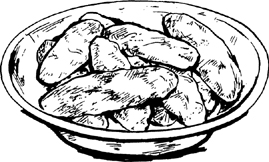Mastering the Art of French Cooking, Volume 2 (203 page)
Read Mastering the Art of French Cooking, Volume 2 Online
Authors: Julia Child

1)
The cookie batter
3 or 4 baking sheets about 12 by 16 inches
1 to 2 Tb soft butter for the baking sheets
3½ Tb soft butter in a 2- to 3-quart mixing bowl
½ cup sugar
An electric mixer
¼ cup egg whites (about 2 egg whites)
Preheat oven to 425 degrees, and set rack in middle level. Prepare baking sheets by smearing each with about 1 tsp of soft butter. Beat the rest of the butter and the sugar together until soft and fluffy; add the egg whites, and beat a few seconds, only just enough to blend.
5 Tb plain cake flour in a sieve or sifter (measure by scooping measuring spoon into flour and leveling off with a knife)
A rubber spatula
⅓ cup ground blanched almonds (grind them in an electric blender)
¼ tsp almond extract
½ tsp vanilla extract
Sieve or sift the flour over the batter, folding it in with a rubber spatula. Fold in the ground almonds, almond extract, and vanilla.
½ cup sliced, shaved, or slivered almonds (either blanched or with skin left on)
Using rubber spatula to dislodge batter, drop ½-teaspoon gobs onto one of the buttered baking sheets, spacing them 3 inches apart. With back of spoon, smear out each blob into a circle 2½ inches in diameter;
batter will be so thin you can see baking sheet through it. Top each circle with a pinch of sliced, shaved, or slivered almonds.
2)
Baking and shaping—oven has been preheated to 425 degrees
A flexible-blade spatula (blade should be at least 8 inches long)
2 bottles or rolling pins braced to lie still
A cake rack
A kitchen timer
Place in middle level of preheated oven, and set timer for 4 minutes. (Meanwhile, make sure rolling pins are ready; then start forming batter on another baking sheet.) Wafers are done when a ⅛-inch border around circumference has browned lightly. Set baking sheet on open oven door so that cookies will keep warm and pliable.
Working rapidly, slide long side of spatula blade under one cookie to scrape and lift it off the baking sheet, and place right side up on rolling pin or bottle. Quickly continue with the rest; the wafers crisp to shape so quickly that the first several may be removed to rack to make room for remaining wafers. (If last wafers have cooled too much for molding, return sheet to oven for several seconds to soften them.)
Close oven door and wait a few minutes for temperature to return to 425 degrees; bake and mold the rest of the wafers in the same manner.
(*) Wafers will stay crisp for several days in dry weather when stored airtight; otherwise, freeze them.
TWO RECIPES FOR LEFTOVER PASTRY DOUGH
Two more good reasons for you to master French puff pastry are
couques
and
palmiers
—crisp, buttery, lightly caramelized cookies that you can make with the leftovers. Like some of the wonderful things you concoct with leftover braised beef,
les tous nus
and
choux farcis
, to give examples from another part of the menu, it is well worth making the original just to have the residue to play with.
THE DOUGH—PUFF PASTRY VERSUS PIE-CRUST DOUGH
Most cookies as well as many of the appetizer and entrée pastries are made with scraps of raw puff pastry left over from
bouchées, vol-au-vent, mille-feuilles
, or other recipes calling for fresh
pâte feuilletée
. These scraps need not be fully reconstituted into puff pastry again,
as described
: those for the
couques
should only be smooth enough to roll out and be cut fairly evenly, and those for the
palmiers
will reconstitute into smoothness as they are rolled in sugar, folded, and rolled and folded again before their final forming. You can convert butter pie-crust dough,
pâte brisée
, formulas 1 or 2
(or even packaged mixes), into a reasonable substitute for puff pastry by rolling and folding with softened butter, as described in the same recipe for reconstituting puff pastry.
COUQUES
[Tongue-shaped Caramelized
Cookies Made from Puff Pastry Dough]
These were made famous in the 1920’s by Le Café de Paris, on the Avenue de l’Opéra. Whenever you ordered ice cream, long
couques
on embroidered napery accompanied each serving, and they soon became the most fashionable cookies in Paris.
Couque
comes from the Flemish
koek
, whose diminutive,
koekje
, produced our “cookie.” We shall not give proportions because they are not necessary, but a circle of dough 3 inches in diameter and ½ inch thick will produce 6 to 8
couques
6 to 7 inches long.
1)
Forming the cookies
Chilled leftover French puff pastry,
pâte feuilletée
An oval fluted cutter 3 to 3½ inches long (or a 2-inch round cutter, preferably fluted)
Preheat oven to 450 degrees in time for Step 2, and set rack in upper-middle level. Roll pastry out about ⅛ inch thick, and cut into ovals (or rounds). Re-form leftovers, roll out again, and cut.



